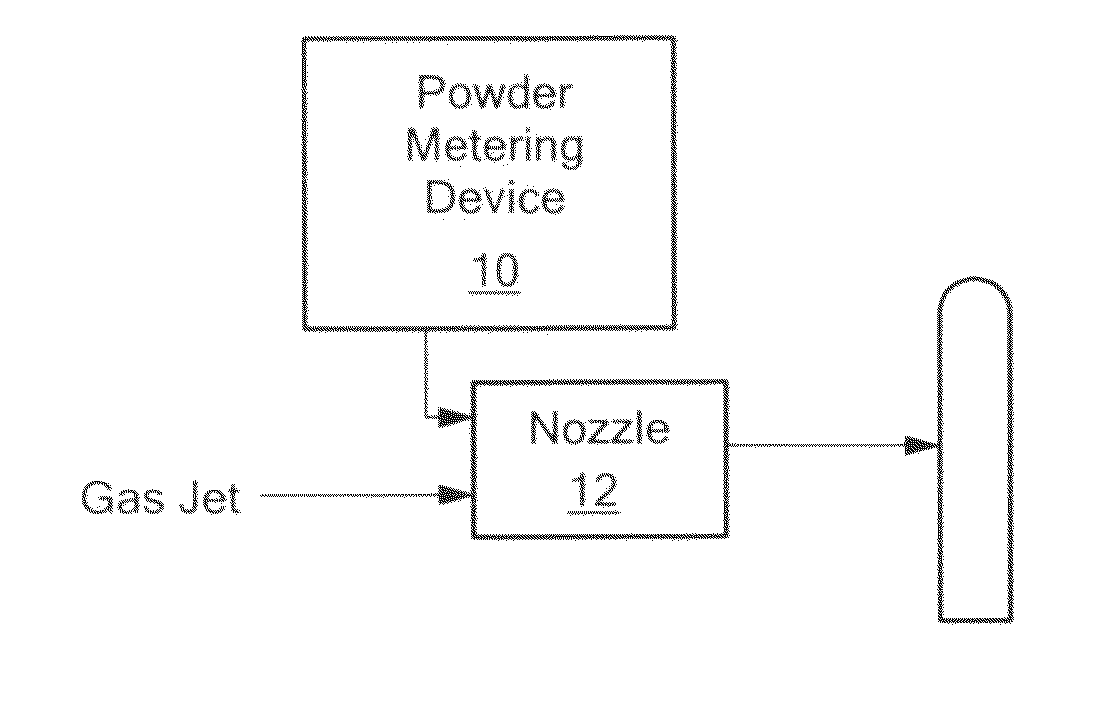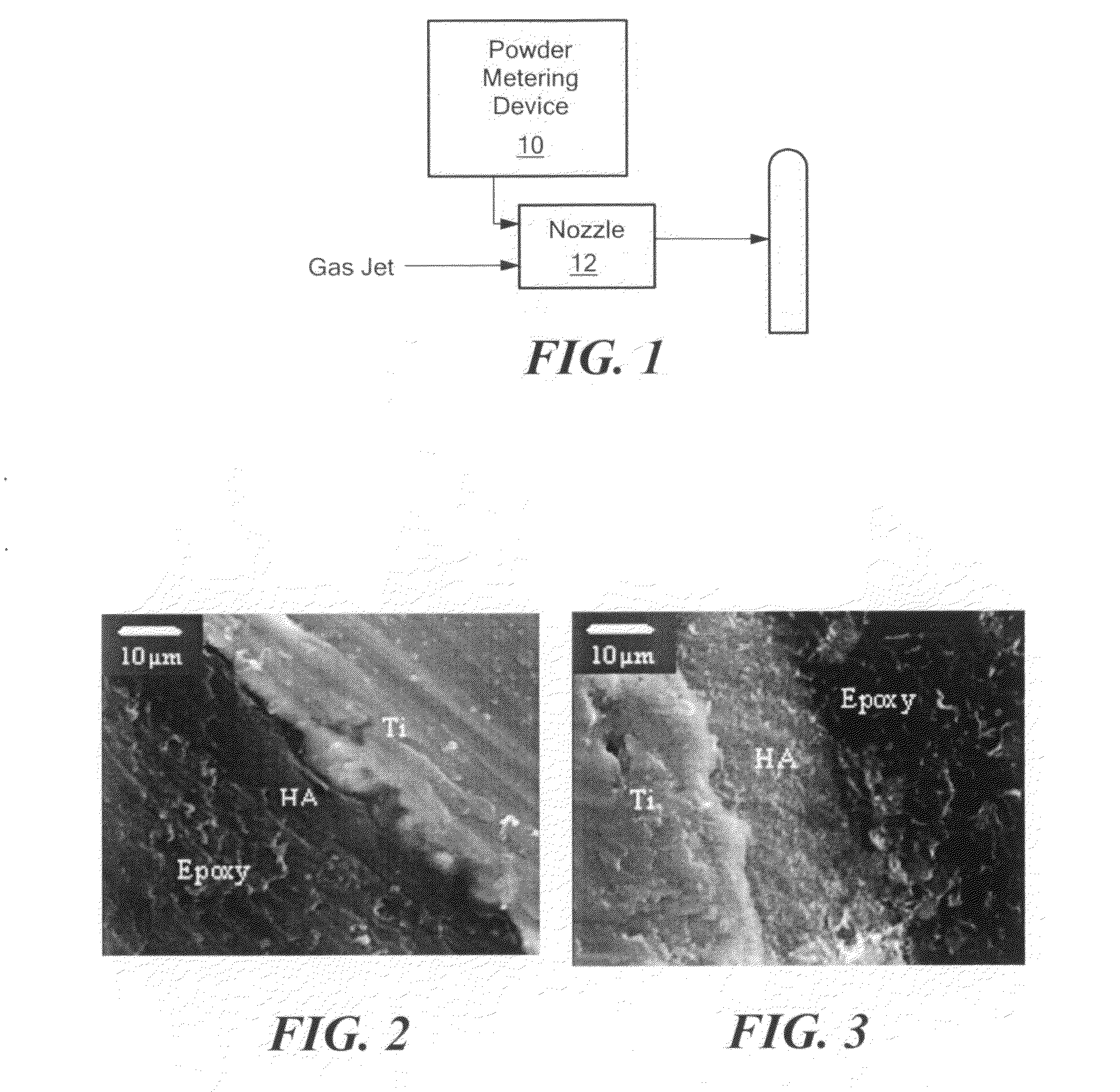Process for depositing calcium phosphate therapeutic coatings with different release rates and a prosthesis coated via the process
a technology of calcium phosphate and release rate, which is applied in the direction of prosthesis, vacuum evaporation coating, surgery, etc., can solve the problems of difficult control of release rate of therapeutic agent, insufficient promotion of bone growth, and unknown polymers used in controlled delivery systems, etc., to achieve the effect of not adversely affecting the efficacy of therapeutic agent and promoting osteogenesis, osteoconduction and osteoinduction
- Summary
- Abstract
- Description
- Claims
- Application Information
AI Technical Summary
Benefits of technology
Problems solved by technology
Method used
Image
Examples
example 1
[0052]APD process can accelerate particles to sonic or supersonic state. Using this process, particles have been deposited on a variety of substrates including Ti SS, CoCr, and the like.
[0053]The process gas is introduced through a gas control module to a manifold system containing Nitrogen gas to a powder-metering device. The high-pressure gas is introduced into the nozzle; the gas accelerates to sonic velocity in the throat region of the nozzle. The flow then becomes sonic as it expands in the diverging section of the nozzle. See FIG. 1. Typical gas jet parameters for the process are summarized in Table 1:
TABLE 1Operation GasAir, nitrogen, helium and mixtureJet Internal Pressure50 to 200psiJet Temperature20 to 30°C.Spray Distance0.5 to 2inchesParticle size.001 to 100μm
[0054]As shown in Table 1, process gases include nitrogen, helium, air, and mixtures of these gases. Nitrogen is a favored process gas because it can be used to spray some materials without promoting oxidation.
[0055]...
example 2
[0064]Experiments were conducted to test the release rate of BMP from various formulations of calcium phosphate. The results have uniquely shown that the release rate is dependent on the crystallinity of the calcium phosphate material. Various formulations of calcium phosphate with BMP were coated on commercially pure (CP) titanium (Ti) coupons (1 cm×1 cm) using the method described above. To measure the release rate, the coated substrates were placed in 12 well plates with cell culture medium (DMEM supplemented with 10% FBS (does not contain BMP); Hyclone) and cultured at 37° C. in 95 / 5% air / CO2 for up to 21 days. Once a day for 21 days, a small amount (5 microliters) of the supernatant solution was removed from each well and the presence of the imbedded proteins were determined by an ELISA assay with antibodies specific to BMP (Biochem). In this manner, the release rates of BMP per each substrate coating type were determined. Experiments were run in triplicate and repeated at thre...
example 3
[0066]In another example, microcrystalline HA was loaded with BMP and then coated onto CP—Ti substrates. These samples were analyzed as described above for release rate. FIG. 9 shows BMP-2 release profile in micrograms over time using microcrystalline HA, exhibiting a bimodal release from day 1 to day 8 and day 17 through day 21 (end of assay). The coating was still present at the end of the assay so BMP release could continue for an unknown period of time. The different lines designate different pressures used during the deposition process. The bimodal release profile shown here is similar to the nano-amorphous CaP / BMP coating. However, one difference is the timing of the second release. The microcrystalline HA / BMP coating releases BMP from day 17 through the end of the test at 21 days.
[0067]In order to verify that the BMP-2 remained active after the deposition process, coated and uncoated samples were analyzed for cell activity. It is known that BMP causes osteoblasts to prolifera...
PUM
| Property | Measurement | Unit |
|---|---|---|
| distance | aaaaa | aaaaa |
| distance | aaaaa | aaaaa |
| distance | aaaaa | aaaaa |
Abstract
Description
Claims
Application Information
 Login to View More
Login to View More - R&D
- Intellectual Property
- Life Sciences
- Materials
- Tech Scout
- Unparalleled Data Quality
- Higher Quality Content
- 60% Fewer Hallucinations
Browse by: Latest US Patents, China's latest patents, Technical Efficacy Thesaurus, Application Domain, Technology Topic, Popular Technical Reports.
© 2025 PatSnap. All rights reserved.Legal|Privacy policy|Modern Slavery Act Transparency Statement|Sitemap|About US| Contact US: help@patsnap.com



